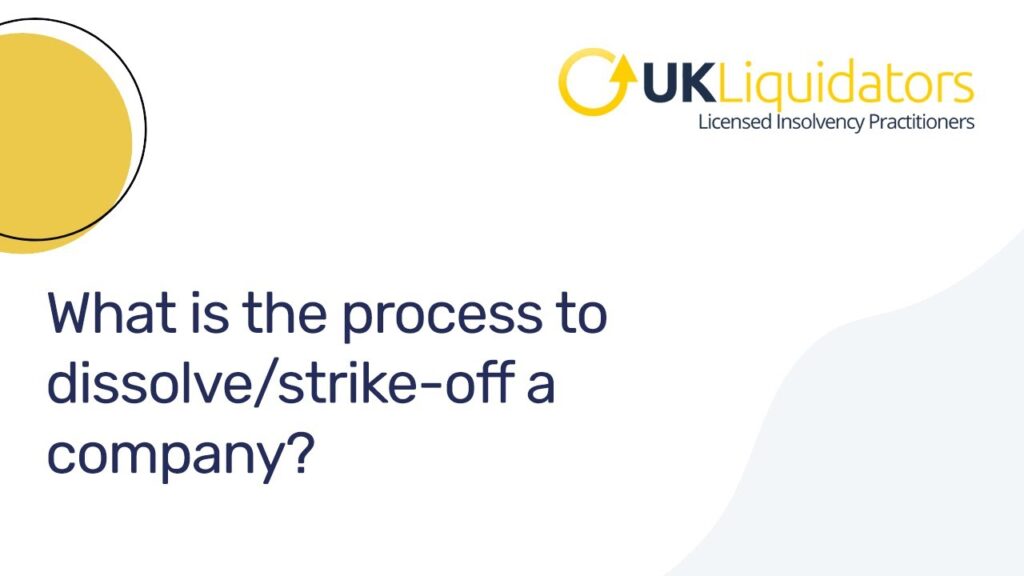A Comprehensive Overview to the Compulsory Strike Off Procedure in Corporate Governance
Navigating the complex landscape of business governance requires a keen understanding of the procedures that govern the dissolution of entities. The mandatory strike off treatment, an essential element in business governance, works as a device to enforce compliance and keep the honesty of the organization atmosphere. As organizations progress and situations modification, the need to strike off a company might arise for numerous factors. Checking out the ins and outs of this process, including the lawful implications, procedural actions, and post-strike off considerations, offers indispensable understandings for stakeholders seeking to browse the intricacies of business administration.

Reasons for Compulsory Strike Off
There are a number of vital reasons that may trigger the initiation of a compulsory strike off procedure for a company. Non-compliance with regulatory requirements can elevate worries concerning the company's operations and monetary health and wellness, leading to the choice to strike off the company from the register.
Furthermore, firms that have actually ceased trading or are no more lugging out any kind of organization tasks might additionally deal with mandatory strike off. This could be as a result of bankruptcy, mergings, or simply a decision to end up the business. In such situations, keeping the company on the register would serve no purpose and can potentially create complication amongst stakeholders.
Inevitably, the need of a mandatory strike off in corporate governance arises when a firm is no much longer running in accordance with the regulation or has ended up being inoperative, requiring its removal from the authorities records.
Lawful Implications and Risks
Provided the situations that trigger a compulsory strike off in business governance, it is important to understand the lawful implications and threats connected with such actions. When a business is struck off the official register, it stops to exist as a lawful entity.
Moreover, there are legal repercussions for people involved in the administration of a company that has actually been by force struck off. Additionally, the reputational damages from a mandatory strike off can have lasting results on people and their capability to involve in future business endeavors.
Action In the Strike Off Process
Initiating the required strike off procedure in corporate governance involves a series of recommended steps outlined by governing authorities. The very first step generally needs the company to submit an official application or notification to the relevant federal government agency or registrar signaling its intent to be struck off the main register. Ultimately, the firm is frequently needed to work out any type of outstanding responsibilities, financial debts, or taxes to make sure conformity with regulative requirements.
Once the preliminary documents is submitted and financial obligations are fulfilled, the governing body will certainly release a notice in a comparable magazine or the official gazette to notify stakeholders regarding the impending strike off - first gazette notice for compulsory strike off. This notice works as a last opportunity for any type of interested parties to elevate objections or present valid factors why the company must not be liquified
Following the magazine of the notification, the regulatory authority will wage the strike off procedure if basics no considerable arguments or barriers arise. The firm will after that be formally liquified, and its name will certainly be removed from the register, properly noting the final thought of the required strike off treatment in company governance.
Records Needed for Strike Off
In conformity with governing standards, particular documents should be provided to help with the strike off procedure in business administration. In addition, monetary statements, such as the business's newest equilibrium sheet, need to be consisted of to guarantee that all financial commitments have actually been cleared up prior to initiating the strike off navigate to these guys treatment. It is important to ensure that all the requisite documents is thoroughly prepared and sent in conformity with the suggested guidelines to expedite the strike off process efficiently.
Post-Strike Off Obligations and Factors To Consider
Complying with the conclusion of the required paperwork for strike off, interest shifts to the post-strike off responsibilities and factors to consider that are necessary in the corporate governance procedure. Once a business has been struck off the register, it is vital to guarantee that all remaining properties are managed properly. This consists of distributing any type of remaining funds amongst investors and resolving any kind of arrearages or obligations. In addition, company directors must ensure that all tax obligation obligations are fulfilled, last staff member payments are made, which all needed filings are finished with appropriate governing bodies.

Conclusion
In final thought, the required strike off treatment in company governance functions as an essential device to eliminate obsolete business from the register. Recognizing the reasons, legal effects, steps, and files needed for strike off is important for compliance with regulative requirements. It is essential for business to meet their post-strike off commitments and take into consideration the effects of this process in order to maintain great standing and avoid possible risks.
There are a number of vital reasons that might trigger the initiation of an obligatory strike off treatment for a business (compulsory strike off). Non-compliance with regulatory needs can elevate issues regarding the company's procedures and economic health and wellness, leading to the choice to strike off the business from the register
